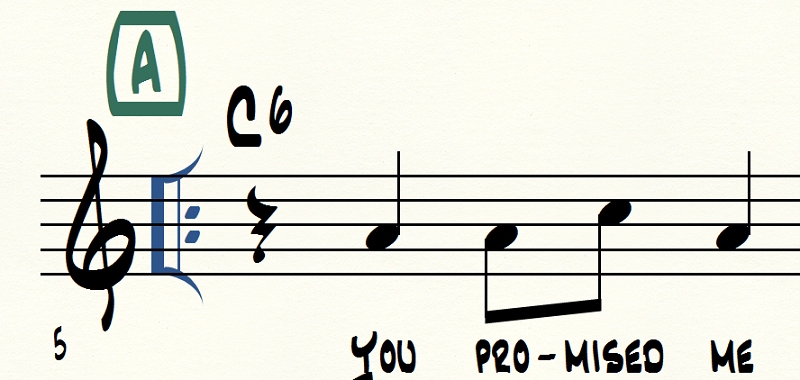I’d like to dive in and discuss rehearsal markings. Isn’t that exciting? The style and type of markings you use can either help or hinder the process of using your chart; also, I’ll discuss the best ways to utilize rehearsal markings in Finale.
Rehearsal marks come in all shapes and sizes. The style you choose to use on your arrangements will largely be dictated by the context the the arrangement will be used in. For our discussion here, we’ll be talking about “section markers” that are called out above specified points in the music (as opposed to a constant bar numbering system, which is often used in tandem).
Finale Tip: For Finale users, Rehearsal Markings fall under the “expressions” tool, and can be mapped to a hotkey (usually “R”). The rehearsal marking expression category allows the markings to appear only on selected staves in the score, but they will appear on each extracted part. You can select a sequential system (numbers, letters, etc.) as described below.
There are generally three categories of rehearsal markings:

- Measure Numbers: These are the literal bar number of the called-out measure, formatted in a distinctive call-out fashion. Probably the most often used, and arguably the most helpful in certain situations- more on that later (Some old-school orchestra and band scores use sequential numbers that are independent of the actual measure numbers; some of which are automatically placed every five bars. Let it be known that those are completely useless. I don’t know what moron came up with that idea).

- Rehearsal Letters: I would venture to guess the second-most commonly used, but IMO the most arbitrary rehearsal style; A, B, C, etc. As you get up there, you can go into A2, B2, C2, etc., or double them up: AA, BB, CC, and so forth.

- Section Names: Very helpful on pop charts, leadsheets, and other “loose form” formats. These range from section callouts (“Chorus,” “Bridge,” “Lead-In,” etc.) to lyric or other cues that assist in indicating what the heck is going on at a certain point.
Overall, it’s important to remember that the purpose of rehearsal markings is communication. Communication between who?
-Between the musicians and the MD
-Between the musicians and the singer
-Between the musicians and each other
…and so forth. Each instance is going to require a different function from the rehearsal markings, so it’s important to consider in advance what the most efficient form of communication will be, given a certain setting.
Let’s look at a couple hypothetical real-world examples:
Singer and the Band: A top 40 singer is fronting his/her band on a weekend corporate gig. Little or no rehearsal was involved beforehand, and the band is mainly composed of pick-up freelancers. In this situation, Section Names would be most appropriate. It’s highly doubtful that the singer knows what bar measure he/she is at at any given moment. Likewise, he/she probably wouldn’t bother memorizing what sections of the tune happen to correspond with letter A, B, or X. It’s a fairly certain bet that he/she knows that they are at the CHORUS, or the BRIDGE, and can shout that out if things go awry.
In this instance, it’s best to communicate with the client and establish what nomenclature will be used for each section. To further clarify, especially in a vocal situation, lyric cues can be very helpful as well:

Producer and the Studio Orchestra: A producer is tracking an orchestra for an album project. From a budget standpoint, time is of the essence. In addition to the producer, there is a conductor, a team of studio engineers, etc. Everyone needs a clear, concise, and efficient understanding of where to go to handle punches, overdubs, splice points, and click track tempo changes. In this situation, Measure Numbers are king. Every bar should have one underneath the barline, and major sections should be highlighted with boxed or circled callouts. It wouldn’t hurt to include section names as well, if it doesn’t clutter up the part.
Lead Sheet on a Jam Gig: A lead sheet is created for a house band to use on a jam session. Everyone will be reading off of the same concert pitch sheet. In this situation, my first choice would be Rehearsal Letters, followed very closely by Section Names, depending on the content of the tune. However, it might be worth formatting those letters a bit differently; for instance, on a tune like “Satin Doll,” whose form is AABA, I would letter the first sections A/A2, the bridge B, and then the last A section with another letter A3 to align the rehearsal letters with the commonly-used bandstand song form nomenclature.
As dull a topic as this might sound, you can see that a carefully planned use of rehearsal markings can increase the usefulness of your arrangement in a given setting.
